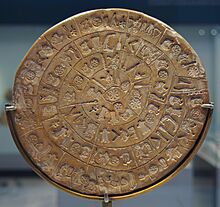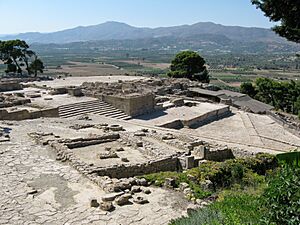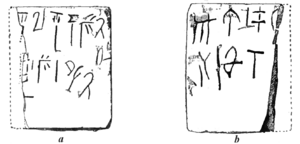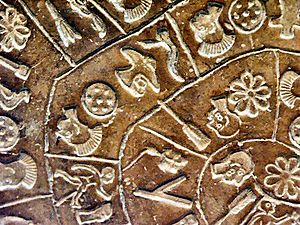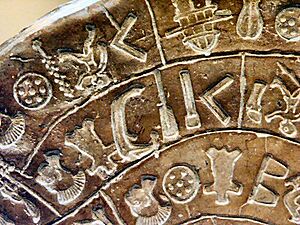Phaistos disc facts for kids
Quick facts for kids Phaistos Disc |
|
|---|---|
|
Phaistos Disc, side A (top) and side B (bottom)
|
|
| Material | Clay |
| Created | 2nd millennium BC |
| Discovered | July 3, 1908 Phaistos, Crete, Greece |
| Discovered by | Luigi Pernier |
| Present location | Heraklion Archaeological Museum, Crete, Greece |
The Phaistos Disc is a mysterious round object made of baked clay. It comes from the island of Crete, Greece. Experts believe it was made a very long time ago, around the Bronze Age (about 2000 to 1000 BC).
This disc has strange symbols carved into both sides. No one knows what the symbols mean or what language they represent. We also don't know why the disc was made or where it originally came from. Today, you can see it at the Heraklion Archaeological Museum in Crete.
The disc was found in 1908 by an Italian archaeologist named Luigi Pernier. It is about 15 centimeters (6 inches) wide. Both sides are covered with a spiral text. There are 241 symbols in total, made from 45 different kinds of signs. These signs were pressed into the soft clay using special stamps before the disc was baked.
At first, some people wondered if the disc was a fake because it was so unique. But now, most archaeologists agree that it is a real ancient artifact. Many people, both experts and hobbyists, have tried to figure out what the symbols mean. They often think the symbols are a type of writing, like an alphabet or a syllabary (where each symbol is a syllable).
Contents
Discovering the Phaistos Disc
The Phaistos Disc was found at an ancient palace site called Phaistos. This site is on the south coast of Crete, near a place called Hagia Triada. The disc was specifically discovered in a basement room of one of the palace buildings.
Italian archaeologist Luigi Pernier found the disc on July 3, 1908. It was in a special underground storage room. This room was covered with a layer of fine plaster. Inside, there wasn't much valuable treasure, but there was black earth, ashes, and burnt animal bones. A few centimeters away from the disc, another ancient clay tablet, called 'PH-1' (written in Linear A), was also found.
How Old is the Phaistos Disc?
Figuring out the exact age of the Phaistos Disc has been tricky. Based on where it was found, some experts like Yves Duhoux believe it was made between 1850 BC and 1600 BC. This time is known as the Middle Minoan period.
However, other experts have different ideas. Some think it might be from after 1400 BC. Because of these different views, it's hard to say for sure. Archaeologists generally agree that the disc could be from anywhere in the Middle or Late Minoan times, which covers most of the second millennium BC.
What the Phaistos Disc Looks Like
Materials and Size
The disc is made from fine clay. Some people think the clay might not even be from Crete itself. Unlike many other ancient clay tablets that were only baked by accident, this disc was carefully and properly fired.
The disc is mostly round, like a cylinder. It's about 16 centimeters (6.3 inches) wide and almost 2 centimeters (0.8 inches) thick. Its edges are rounded. One side of the disc is slightly curved inward (concave), and the other side is curved outward (convex).
An Early Form of Printing?
One of the most amazing things about the Phaistos Disc is how its symbols were made. Each symbol was pressed into the soft clay using a separate stamp. This means the disc is like a very early example of "movable type" printing.
Imagine having a set of stamps, one for each letter or symbol. You could arrange them to print words. This is similar to how the Phaistos Disc was made. A linguist named Herbert Brekle said that if the disc is a text, then it truly is a "printed" text. This is because the individual "types" (the stamps) were used many times on the clay disc.
Lines and Marks
Besides the stamped symbols, there are also some marks made by hand. These marks were scratched into the wet clay with a sharp tool. On each side of the disc, there's a spiral line that separates the rows of text. Short lines also divide these rows into sections, with each section holding a few symbols.
The very beginning of the text, near the edge of the disc, is marked by a special line. This line has five dots punched along it. Also, under some of the stamped symbols, there are small slanted lines.
The Symbols on the Disc
There are 45 different kinds of symbols on the Phaistos Disc. These symbols appear a total of 242 times. Side A has 123 symbols, and side B has 119. In addition to these, a small diagonal line was scratched under 18 of the symbols.
The famous archaeologist Arthur Evans gave numbers to these 45 symbols, from 01 to 45. Most researchers still use his numbering system today. These symbols were even added to the Unicode computer character set in 2008, so computers can display them.
Many of the symbols look like real objects, such as people, birds, plants, or a boat. However, we don't know exactly what most of these objects are. The names given to the symbols by scholars, like "PEDESTRIAN" or "HELMET," are just guesses based on what they look like.
For example, symbol 21, called "COMB," was once thought to be a map of a palace floor. But then, a vase was found with a very similar symbol on its bottom, which was likely a potter's mark. This made the "palace map" idea less likely.
Symbol 20, called "DOLIUM," was thought to be a large sea snail shell. A shell like this was found at Phaistos and might have been used as a musical instrument in ancient rituals.
How Symbols Are Used
The way the symbols are spread out on the disc is not random. Some symbols appear much more often than others, and their use is different on side A compared to side B. For example, symbol 02 (PLUMED HEAD) is the most common, appearing 19 times, with 14 of those on side A. Symbol 07 (HELMET) appears 18 times, mostly on side B.
Even though some symbols are more common on one side, 26 of the 45 symbols appear on both sides of the disc.
Reading the Text
The symbols on each side of the disc form a single spiral text. This text is divided into groups by the short lines scratched into the clay. These groups are often called "words," even though we don't know if they are actual words in a language.
There are 61 such "words" on the disc: 31 on side A and 30 on side B. Each "word" has between two and seven symbols. These "words" are usually numbered A1 to A31 and B1 to B30.
Most experts agree that the text should be read in a clockwise direction, starting from the outside edge and moving inward towards the center. This is similar to how another ancient spiral inscription, the Lead Plaque of Magliano, is read. The special radial line with five dots marks the presumed start of the text on both sides.
The small slanted lines under some symbols are always found at the end of a "word." Some people think these lines might divide the text into "paragraphs."
Changes and Rotations
The disc shows that some corrections were made. Some symbols were erased, and new ones were pressed over them. This tells us that the person making the disc could fix mistakes.
Interestingly, some symbols appear rotated. For example, two "HIDE" symbols in one "word" on side A are upside down compared to all other "HIDE" symbols. This might have been done because there wasn't enough space.
Where Did the Disc Come From?
For many years after its discovery, most experts thought the Phaistos Disc did not come from Crete. They believed this because its symbols looked very different from other known Cretan writing systems, like the Minoan hieroglyphs or Linear A. Some even said the clay itself wasn't from Crete.
However, this idea changed over time. Other artifacts were found on Crete that had symbols similar to those on the disc. For example, a vase found at Knossos had a stamped symbol just like the disc's "SHIELD" sign. Also, a bowl found at Phaistos had a mark similar to the disc's "COMB" sign. These discoveries made it more likely that the Phaistos Disc was indeed made on Crete.
Was it a Hoax?
Because the Phaistos Disc is so unique – with its spiral text and stamped symbols – some scholars wondered if it was a fake made in 1908. They pointed out that the disc's age had never been confirmed using modern scientific methods like thermoluminescence dating.
However, archaeologists now generally accept the disc as real. The detailed records kept by Luigi Pernier during the excavation made it hard to believe it was a hoax. Also, the later discoveries of other artifacts on Crete with similar symbols helped prove its authenticity. A gold ring found in 1926 also had a spiral inscription, similar to the disc.
Trying to Understand the Disc
Many people have tried to decipher (figure out the meaning of) the symbols on the Phaistos Disc. There are many different ideas about what the disc might be. Some think it's a prayer, a story, a call to arms, a board game, or even a math problem. Some of these ideas are not taken seriously by experts.
Most experts who believe it's a form of writing think it's a syllabary. This is because the number of different symbols (45) compared to the total number of symbols (241) fits with how syllabaries usually work. A syllabary uses one symbol for each syllable (like "ba," "be," "bi").
However, it's very difficult to decipher the disc without more examples of the same writing. Most scholars believe that unless more texts with these symbols are found, it's unlikely that anyone will be able to fully understand the Phaistos Disc. Any attempt to decipher it would need to be confirmed by comparing it to other similar inscriptions.
Comparing with Other Writings
Some scholars have tried to compare the Phaistos Disc's symbols to other ancient writing systems. They suggest that the disc's creator might have been influenced by other scripts, even if the Phaistos Disc is unique.
Some have looked for similarities with Linear A glyphs, which is another ancient Cretan script. Others have compared them to Anatolian hieroglyphs or Egyptian hieroglyphs. While some symbols might look a bit alike, there's no clear match that has led to a full decipherment.
Modern Use
Side A of the Phaistos Disc is used as the logo for FORTH. This is one of the largest research centers in Greece.
See also
 In Spanish: Disco de Festo para niños
In Spanish: Disco de Festo para niños
- Mehen (game)
- Arkalochori Axe
- Cretan hieroglyphs
- Linear A
Images for kids


